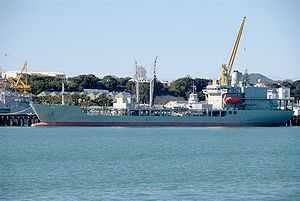
The Royal New Zealand Navy is the maritime arm of the New Zealand Defence Force. The fleet currently consists of nine ships.
HMNZS Charles Upham (A02) was a Mercandian 2-in-1 class roll-on/roll-off vessel operated by the Royal New Zealand Navy (RNZN) between 1994 and 2001. The vessel was built for the Danish shipping company Mercandia during the early 1980s, and operated under the names Mercandian Queen II and Continental Queen II. The New Zealand Defence Force had identified the need for a logistic support ship as early as the 1970s but it was not until the 1991 white paper that planning to acquire a ship commenced in earnest. Mercandian Queen II was for sale around that time, and although not as capable as the RNZN had initially specified, was purchased in 1994.

The Anzac class is a ship class of ten frigates; eight operated by the Royal Australian Navy (RAN) and two operated by the Royal New Zealand Navy (RNZN). During the 1980s, the RAN began plans to replace the River-class destroyer escorts with a mid-capability patrol frigate, and settled on the idea of modifying a proven German design for Australian conditions. Around the same time, the RNZN was seeking to replace their Leander-class frigates while maintaining blue-water capabilities. A souring of relations between New Zealand and the United States of America in relation to New Zealand's nuclear-free zone and the ANZUS security treaty prompted New Zealand to seek improved ties with other nations, particularly Australia. As both nations were seeking warships of similar capabilities, the decision was made in 1987 to collaborate on their acquisition. The project name is taken from the Australian and New Zealand Army Corps of the First World War.

HMNZS Te Kaha (F77) is one of ten Anzac-class frigates, and one of two serving in the Royal New Zealand Navy (RNZN). The name Te Kaha is Māori, meaning 'fighting prowess' or 'strength'.
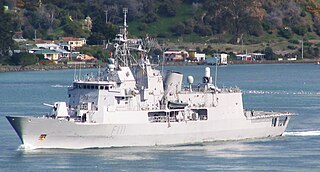
HMNZS Te Mana (F111) is one of ten Anzac-class frigates and one of two serving in the Royal New Zealand Navy (RNZN). The name Te Mana is Māori, approximately translating as 'status' or 'authority'. The ship was laid down under the joint Anzac project by Tenix Defence at Williamstown, Victoria in 1996, launched in 1997, and commissioned into the RNZN in 1999.

HMNZS Resolution (A14) was a hydrographic ship of the Royal New Zealand Navy (RNZN). Originally the United States Naval Ship USNS Tenacious (T-AGOS-17), the Stalwart-class ocean surveillance ship was used by the United States to locate and track Soviet submarines from 1989 to 1997, when she was transferred to the RNZN for use as a hydrographic survey ship. She served until 27 April 2012. She was subsequently sold to EGS Group, a private surveying company, and renamed RV Geo Resolution.

HMNZS Wellington was a Leander-class frigate of the Royal Navy and the Royal New Zealand Navy (RNZN). Originally commissioned in 1969 for the Royal Navy as HMS Bacchante, she joined the RNZN in 1982. She was decommissioned in 1999 and sunk in 2005.

HMAS Sirius is a commercial tanker purchased by the Royal Australian Navy and converted into a fleet replenishment vessel to replace HMAS Westralia. She is named in honor of HMS Sirius of the First Fleet. Launched in South Korea on 2004, and converted in Western Australia, Sirius was commissioned in 2006; three years before a purpose-built vessel would have been built, and at half the cost. The tanker is expected to be replaced in 2021.

The Moa-class patrol boat is a class of patrol boats built between 1978 and 1985 for the Royal New Zealand Navy by the Whangarei Engineering and Construction Company. They were based on an Australian boat design.
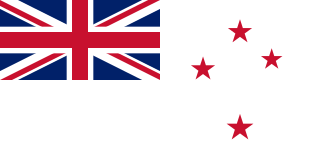
The history of the Royal New Zealand Navy leads back to early New Zealand-based gunboats used in controlling the British interests in the new colony, as well as to the strong linkages to the British Navy itself.
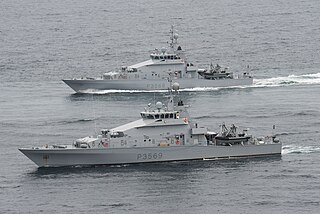
The Lake-class inshore patrol vessel is a ship class of inshore patrol vessels (IPVs) of the Royal New Zealand Navy (RNZN) which replaced the RNZN's Moa-class patrol boats in 2007–2008. All four vessels are named after New Zealand lakes.

Project Protector was a Royal New Zealand Navy (RNZN) procurement project that was undertaken during the 2000s. At the start of the decade, the New Zealand government tasked the New Zealand Defence Force to develop an equal combat, peacekeeping, and disaster relief capability, in which the RNZN was to focus on conducting sealift operations and patrols of the Economic Exclusion Zone. A series of reviews found that the RNZN was lacking in these capabilities, and Project Protector was established to acquire three new ship types: a single multi-role sealift ship, two offshore patrol vessels, and four inshore patrol vessels. After a two-year information-gathering and tender process, an Australian company, Tenix Defence, was selected as the primary contractor.
HMNZS Waikato (F55) was a Leander Batch 2TA frigate of the Royal New Zealand Navy (RNZN). She was one of two Leanders built for the RNZN, the other being the Batch 3 HMNZS Canterbury. These two New Zealand ships relieved British ships of the Armilla patrol during the Falklands conflict, freeing British ships for deployment.

HMNZS Manawanui (A09) was commissioned in 1988 as a diving support vessel for the Royal New Zealand Navy. Originally she was built as a diving support vessel, the Star Perseus, for North Sea oil rig operations.

HMNZS Kahu (A04) was a Moa-class inshore patrol vessel of the Royal New Zealand Navy. She was launched in 1979 as the lead boat of her class, modified to function as a diving tender. She was initially named HMNZS Manawanui (A09), the second of soon to be four diving tenders with this name to serve in the New Zealand Navy. As a diving tender she participated in the exploration and salvage work of the wreck MS Mikhail Lermontov in March 1986.

HMNZS Canterbury (F421) was one of two broad beam Leander-class frigates operated by the Royal New Zealand Navy (RNZN) from 1971 to 2005. She was built in Scotland and launched in 1970. Commissioned in 1971, Canterbury saw operational service in much of Australasia and other regions like the Persian Gulf. She undertook operations such as supporting UN sanctions against Iraq and peace-keeping in East Timor. With her sister ship HMNZS Waikato she relieved the Royal Navy frigate HMS Amazon in the Indian Ocean during the Falklands War. Early in HMNZS Canterbury's career, in 1973, she relieved the frigate HMNZS Otago, as part of a unique, Anzac, naval operation or exercise at Moruroa during anti-nuclear protests, supported by a large RAN tanker, providing fuel and a large platform for Australian media. This was due to F 421 being a more modern RNZN frigate, with then current Rn surveillance radar and ESM and a more effectively insulated frigate from nuclear fallout, with the Improved Broad Beam Leander steam plant, for example, being remote controlled and capable of unmanned operation and therefore the ship provided a more effective sealed citadel for operations in areas of nuclear explosions.
HMNZS Monowai (A06) was a hydrographic survey vessel of the Royal New Zealand Navy (RNZN). Built in 1960, the ship was originally used as a civilian supply and passenger vessel by the New Zealand Government, under the name GMV Moana Roa, before being acquired by the RNZN in 1977. She remained in RNZN service until 1997, performing various duties such as coastal surveying, resupply, and surveillance. After being decommissioned she was sold to civilian operators in Britain in 1998 for conversion to a cruise ship, but was found unsuitable for the role and eventually sent to Spanish shipbreakers in 2002.
HMNZS Manawanui (1948) was a naval tug which was modified for use as a diving tender by the Royal New Zealand Navy (RNZN). Originally intended for service with the United States Navy as a tug, the vessel was built in 1945 and transferred to the New Zealand Marine Department, which employed her in Waitemata Harbour before transferring the ship to the RNZN in 1948. She was converted to a diving tender in 1953 and served out her time in the RNZN in this role, before being decommissioned in 1978 and sold to the Paeroa Historic Maritime Park.
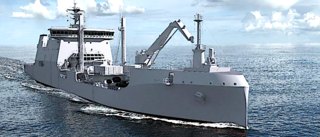
HMNZS Aotearoa, formerly the Maritime Sustainment Capability project, is an auxiliary ship of the Royal New Zealand Navy. Builder Hyundai Heavy Industries delivered the ship to the Navy in June 2020, and she was commissioned into service on 29 July 2020. Full operational capability was expected to be achieved in 2021. It will serve as a replenishment oiler, and will replace HMNZS Endeavour, the Navy’s last fleet oiler, which was decommissioned in December 2017.

HMNZS Manawanui is a multi-role offshore support vessel currently commissioned in the Royal New Zealand Navy. The ship replaces two decommissioned vessels, the hydrographic survey ship HMNZS Resolution and the diving support vessel HMNZS Manawanui.
